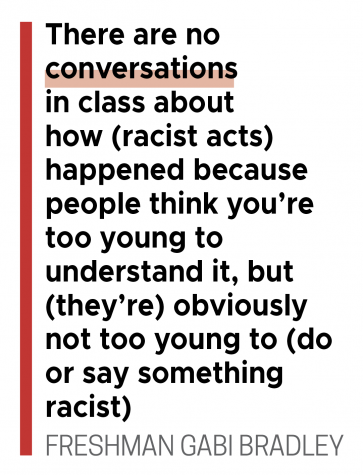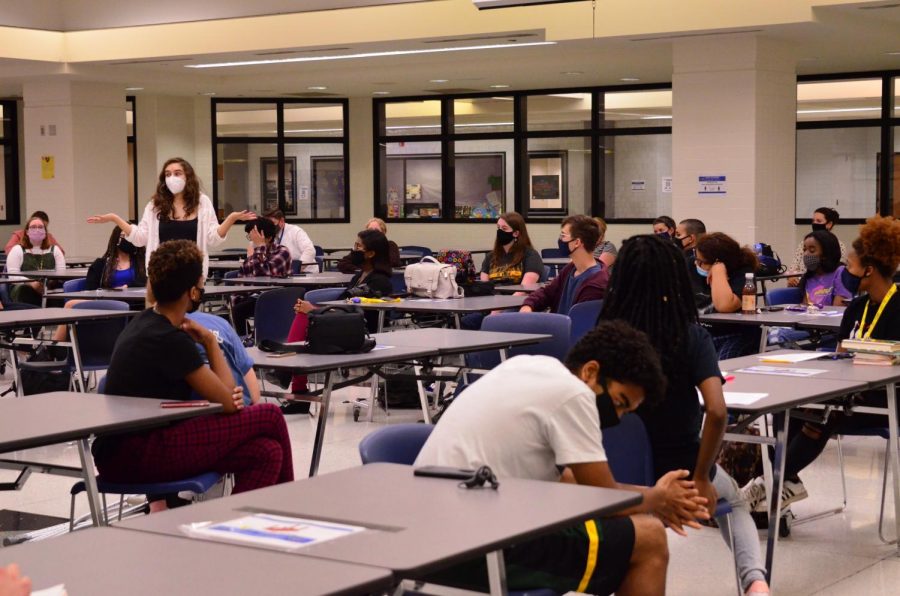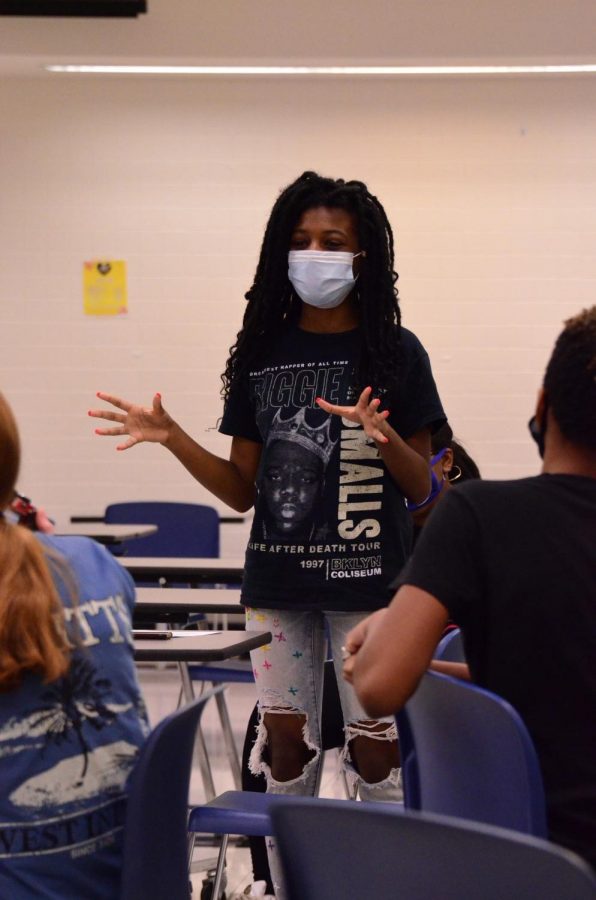Like most students her age, Gabi Bradley, Black Student Alliance (BSA) member and freshman, is in the process of becoming familiar with this school. However, throughout her education at Carmel Clay Schools, which is predominantly white, said she has already become familiar with racism, experiencing uncomfortable situations because she is Black.
“It’s disappointing but it’s not surprising because (racism is) not talked about and (we are) not educated about it,” Bradley said. “There are no conversations in class about how (racist acts) happened because people think you’re too young to understand it, but (they’re) obviously not too young to (do or say something racist).”
Bradley is not alone. According to a 2019 Pew Research Center Study, 69% of Black students in high school or lower grades have dealt with discrimination. From this group, 9% of Black students said they deal with this issue regularly while 60% said they deal with discrimination from time to time.
Bradley said she wanted to find a club where she could become acquainted with and relate to other Black students here.
“I thought it was important (to join BSA) because as a Black student, it would bea really good way to get to know other Black students, especially upperclassmen,” Bradley said. “I was in Black Student Union last year in eighth grade, so I feel like it’s a really good way to gain some perspective and to also get myself into high school and get involved as well.”
That same 2019 Pew Research Center study further found that 52% of Black people said people have made racial slurs or jokes about them. Additionally, 43% of Black people said they are fearful for their own safety due to racism.
Morgan Blakey, BSA co-founder and co-president and senior, said she formed the club with Selam Waclawik, co-president and senior, because they felt it was a necessity to have a place where minority Black students could connect.
“We just decided to make this club to be a safe space for Black students to come and talk about their issues and their grievances,” Blakey said. “A lot of times, we have Black students in our club who don’t always get to say what they want to say in a predominantly white institution because they would receive judgement for saying, ‘That doesn’t sound right’ or maybe, ‘I don’t agree with that opinion that you have.’”
In addition to the racism that Black students face, other minority groups report experiencing racism whether that be through a recent increase in stigma due to the COVID-19 pandemic or the stereotype of Asians as the “model minority.” A report from the Asian American Pacific Islander (AAPI) Hate Youth Campaign stated that 77% of AAPI youth are angry about anti-Asian racism and 60% are also upset with the ongoing issue of racism.
Elijah Choi, Advancement of Asian Americans in Arts and Athletics (A5) co-founder and co-president and senior, said because racism against Asians and the stereotype of a “model minority” is a prevalent issue at this school, he, along with the other co-founders, decided to found A5.
“We decided that we wanted to be the people who could show you know the majority of Asian people at Carmel High School that they can follow unconventional paths that they want to,” Choi said. “(We also wanted to) show the rest of Carmel High School that Asian Americans aren’t necessarily always held to that stereotype of being really smart, good at math, that kind of thing.”
In order to further combat racism, BSA hosted a meeting on Sept. 24 with Principal Tom Harmas to discuss racism at CHS, the administration’s response, and how to move forward. At this meeting, which A5 was invited to, students such as Bradley shared their experiences with racism at Carmel Clay Schools.
Bradley said, “I think it’s important (to share experiences with racism) not only for students not of color and other students who are of color because it empowers students who are of color to talk about their experiences and to bring them up because a lot of people just don’t talk about (racism) and it provides people who are not people of color to really get some perspective about how it is to be a person of color at a largely-white school.”
Additionally, BSA members shared their concerns with the administration’s response to acts of racism as well as different initiatives they want the administration to take in order to combat racism. Blakey said these initiatives include a more diverse staff.
“We (said) we need more administrators (who are people) of color because we don’t see ourselves up on the administration board and (we need a Black) counselor at least because Black students have problems too and (the school) not having a Black counselor (is) kind of just like saying, ‘Oh (Black students) don’t really have problems’—that’s kind of what it makes (you) feel,” Blakey said. “To be honest, you can’t really get close to talking to a white counselor about Black people problems like Black issues. They can try to understand it, but they never really will because they’ve never experienced it before.”
Moreover, A5 talked about the inherent stereotype of Asians as being really good in subjects such as math and science and how the school has fostered this stereotype.
“I think the meeting as a whole was productive because not only were we able to voice our opinions and what the facts were and how we felt about that situation, but it was also a time where the people in charge had to sit down and listen,” Choi said. “That’s something that I feel like doesn’t happen a lot where we’re able to have a civil discussion about both points of view and I feel like that meeting was able to create that discussion and being able to say, ‘Hey this is what we want to not only help us, but any group of people who feel targeted’—that can really make a difference.”
Furthermore, BSA pushed for more initiative from the school in education on racism as well as the promotion of Black History Month and Black history in general. Moreover, they advocated for the diversification of texts in English classes.
“Another one of our demands (was) incorporating African American literature into the school system and English classes instead of reading these oppressive books that put down Black people like (The) Great Gatsby and those books that just talk bad about Black people.”

In response to the widespread issue of racism at CHS, the administration has been trying to find different ways to better improve the environment for people of color. According to Assistant Principal Valerie Piehl, the administration acknowledges that there is a need for improvement in regards to racism at this school.
“We want to make sure every one of our students feels safe and accepted and loved and cared for and welcomed by their fellow students, by teachers, by administration and obviously, we feel like this is something (where) we have some work to do and some areas we can grow and get better.”
Moreover, the administration started a three-year plan—a cycle of continuous improvement—with two goals: equity and inclusion, and social and emotional learning.
Piehl said, “There are some things that are kind of already in progress, one of the students (at the meeting) talked about books that are being read in classes and that’s something that we, even with the English department last year, were working on. (We were working on) materials adoption and, unfortunately, the pandemic shut us down right when we were getting to the core of that work, (but) we’re picking that up this year, and so by next year for sure, we will be selecting new (more diverse) texts and materials to be reading in all of our English classes.”
Blakey said she is glad to hear the administration is making this change. Furthermore, Choi also said it is imperative for people who are not of color to stand up when they see something racist and to handle those situations not only delicately, but firmly in order to find solutions. Bradley said she agreed with this message to people who are not of color regarding racism.
“Here’s the thing, when you have privilege, you can use it. Now, you don’t have to do the whole ‘white savior’ act and save everybody because, as a Black community, we can do that on our own—we’re very smart and educated as a whole,” Bradley said, “but you have privilege and you can use it to your advantage and being aware of that privilege helps you use it to better the lives of other people. I understand (that it’s) uncomfortable (and) I get (racism is) hard to talk about. (However) I just don’t like using the word uncomfortable because it’s uncomfortable for the people who have to live it (and) it’s uncomfortable to be called slurs in the hallway everyday. You don’t have to face that discomfort so you just have to get through it, so that you can help protect those people that are facing that discomfort.”

































![AI in films like "The Brutalist" is convenient, but shouldn’t take priority [opinion]](https://hilite.org/wp-content/uploads/2025/02/catherine-cover-1200x471.jpg)










































![Review: “The Immortal Soul Salvage Yard:” A criminally underrated poetry collection [MUSE]](https://hilite.org/wp-content/uploads/2025/03/71cju6TvqmL._AC_UF10001000_QL80_.jpg)
![Review: "Dog Man" is Unapologetically Chaotic [MUSE]](https://hilite.org/wp-content/uploads/2025/03/dogman-1200x700.jpg)
![Review: "Ne Zha 2": The WeChat family reunion I didn’t know I needed [MUSE]](https://hilite.org/wp-content/uploads/2025/03/unnamed-4.png)
![Review in Print: Maripaz Villar brings a delightfully unique style to the world of WEBTOON [MUSE]](https://hilite.org/wp-content/uploads/2023/12/maripazcover-1200x960.jpg)
![Review: “The Sword of Kaigen” is a masterpiece [MUSE]](https://hilite.org/wp-content/uploads/2023/11/Screenshot-2023-11-26-201051.png)
![Review: Gateron Oil Kings, great linear switches, okay price [MUSE]](https://hilite.org/wp-content/uploads/2023/11/Screenshot-2023-11-26-200553.png)
![Review: “A Haunting in Venice” is a significant improvement from other Agatha Christie adaptations [MUSE]](https://hilite.org/wp-content/uploads/2023/11/e7ee2938a6d422669771bce6d8088521.jpg)
![Review: A Thanksgiving story from elementary school, still just as interesting [MUSE]](https://hilite.org/wp-content/uploads/2023/11/Screenshot-2023-11-26-195514-987x1200.png)
![Review: "When I Fly Towards You", cute, uplifting youth drama [MUSE]](https://hilite.org/wp-content/uploads/2023/09/When-I-Fly-Towards-You-Chinese-drama.png)
![Postcards from Muse: Hawaii Travel Diary [MUSE]](https://hilite.org/wp-content/uploads/2023/09/My-project-1-1200x1200.jpg)
![Review: "Ladybug & Cat Noir: The Movie," departure from original show [MUSE]](https://hilite.org/wp-content/uploads/2023/09/Ladybug__Cat_Noir_-_The_Movie_poster.jpg)
![Review in Print: "Hidden Love" is the cute, uplifting drama everyone needs [MUSE]](https://hilite.org/wp-content/uploads/2023/09/hiddenlovecover-e1693597208225-1030x1200.png)
![Review in Print: "Heartstopper" is the heartwarming queer romance we all need [MUSE]](https://hilite.org/wp-content/uploads/2023/08/museheartstoppercover-1200x654.png)






